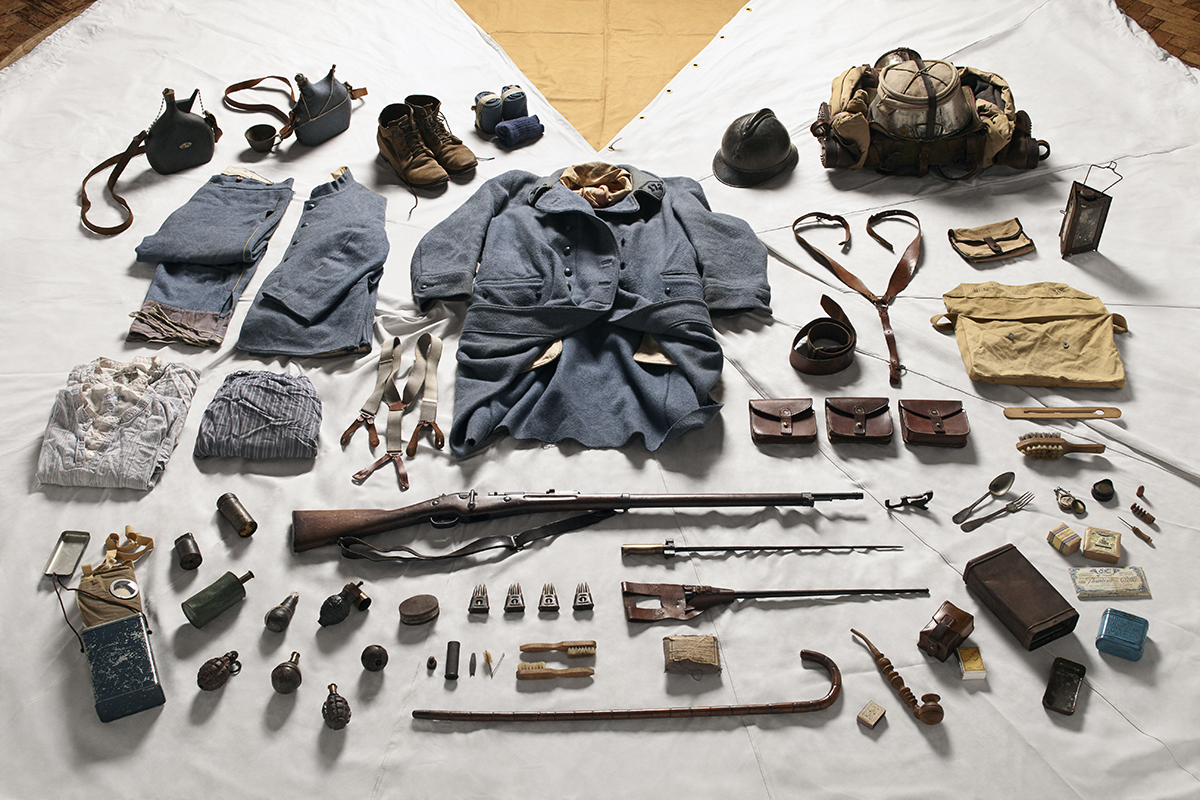The creation of a short and handy Mosin Nagant carbine to complement the standard M891 was prompted by the Russo-Japanese War. Lots of Russian troops with roles other than infantry – machine gun and artillery crews in particular – were unnecessarily burdened with full length rifles, and the Model 1907 carbine was intended to fix that. Produced at the Izhevsk Arsenal, the model was adopted in 1907 and made until 1914. A total of about 344,000 were originally made (not that the serial numbers reset at 1 for each year of production), but very few survive today.
Mechanically, the receiver and butt of the 1907 is identical to the M1891. The carbine differs in its handguard, sights, and 20 inch (508mm) long barrel.
There were two patterns of the Model 1907, as the rear sight changed in 1908 to match the then-new Spitzer bullet adopted by the Russian military. The first pattern is graduated up to 1900 arshins and the second pattern (like this one) goes to 2000 arshins, thanks to the increased velocity of the new ammunition. In addition, a recoil bolt was added to the guns around 1910 to help handle the increased recoil of that new ammunition (some earlier guns were retrofitted with those recoil bolts as well).
Ultimately, the 1907 was judged to have very intense flash and recoil, and not considered a particularly successful design. With the outbreak of World War One, production was stopped in favor of making more of the M1891 rifles instead. Of course, carbines like the 1907 would return with the M38 and M44 a few decades later…




I had an M44 Mosin. That puppy was a kicker, and the folding bayo would hurt you if you fired the gun with it folded.
The M38 I had had no bayonet, but after about two five-round magazines the spring-retained barrel bands had “jumped” over the springs and forward as much as 2cm, due to recoil.
Reading up on it, I learned that Russian and Finnish soldiers would wedge wood matchsticks under the springs to at least delay this aggravation.
cheers
eon
I have seen (and heard) a Hungarian made version of Mosin carbine on range. It had incorporated bayonet just like you see in Mr. Miculek video https://www.youtube.com/watch?v=56H1601J9sE
It was well built but uncomfortably loud. Its owner was aptly equipped with quality hearing protection.
All of these weapons were of questionable utility. I’m unsure of just why they didn’t issue downloaded cartridges to match the potential ballistics, because all that flash and bang indicate massive waste of resources when you spread that across all the fired full-power cartridges that went through these carbines.
You really have to wonder, sometimes: Why the hell were the various “authorities” so wedded to the overpower solutions that they were? The sole bit of comprehensible common sense you can find from that era came from the various Nordic and Alpine neutrals, all of whom opted for better solutions than the “Great Powers”.
The US I can kind of understand; the Frontier made it look like long-range riflery made more sense for US Army potential conflicts, but the Europeans? Good grief… All of them opted for “too damn much”, in terms of recoil energy, range, and all the rest. Zero attention paid to obvious precursors like the Russo-Japanese War, where the shape of things to come was fairly obvious.
I have to wonder, sometimes, just how many lives would have been saved, had there been some sense to what they were doing. The French, for example? Dear God, the sheer human waste of all those “furia francese“-esque attacks on the Western Front…
“(…)why they didn’t issue downloaded cartridges(…)”
Czarist land forces were conscript powered with many of them having very low technical culture. Introducing same-shaped but different-behaving cartridge would probably cause issues.
‘(…)The sole bit of comprehensible common sense you can find from that era came from the various Nordic and Alpine neutrals, all of whom opted for better solutions than the “Great Powers”.(…)”
Wait… what about Spain and their 7 x 57 cartridge? Did it produced obnoxious sound when fired from carbine length barrel?
“(…)obvious precursors(…)Russo-Japanese War(…)”
???
Defeat which Russian Empire suffered was painful and resulted in upgrade of Russian military, I do not have English article dealing with that, only Russian-language one, namely https://ru.wikipedia.org/wiki/%D0%92%D0%BE%D0%B5%D0%BD%D0%BD%D1%8B%D0%B5_%D1%80%D0%B5%D1%84%D0%BE%D1%80%D0%BC%D1%8B_(1905%E2%80%941912)
“Long range riflery” was pretty much a myth on the frontier, too.
Buffalo hunters may have used things like .50-70s and .45-70s, but it was for muzzle energy, not range; the usual range of engagement was under 200 yards. Bison were and are pretty stupid animals, and a two-man team of hunters could shoot a couple of dozen before the rest decided to mosey on down the trail. The really powerful, high-velocity (for the time) cartridges like the .50 3 1/2″ Sharps Straight only showed up in the early 1880s- years after the buffalo hunting period was very much over with.
As for “fightin’ Injuns”, if you check the known engagements from the Fetterman massacre, to the Wagon Box fight, and on to the Greasy Grass (Little Big Horn to the U.S. Army), range of engagement was rarely more than 100 yards; pistol range. Rate of fire was what was needed, not long range. (Sound familiar?)
Custer’s men had only been re-equipped with the Springfield carbine (.45-55 load) a month before the battle; before that they’d had Spencer carbines, the same as the unit Custer had commanded during the Civil War. Custer’s tactics were pretty much what he and every other Union cavalry commander with Spencer-armed units had used then. If the 7th had still had Spencers, that battle would likely have ended very differently.
When rate of fire was applied correctly by the defenders, the result was a bad day for the attackers. As at Northfield, MN, 7 Sept 1876, and Columbus, NM, 9 Mar 1916.
Important safety tip; even with 200+ guys on horseback, do not tangle with a machine-gun section with M1909 Benét–Mercié machine rifles backed up by a lot of pissed-off civilians with Winchesters.
cheers
eon
As far as I’m concerned, the average grunt isn’t worried about saving every cartridge for the mythical one-shot-stop. He’s worried about getting killed. I mean, if some ax-swinging maniac jumped out of the bushes to get me and I’m clearly within 20 feet of him, I’m not going to attempt a one-shot-stop. I’d empty a full magazine’s worth of ammunition into the dude, so he doesn’t ax me to leave this world. I could be wrong.
What was Stalin’s line, supposedly? “Quantity has a quality all of it’s own…”
Then again, there’s probably significant psychological advantage accruing from firing something like a Mosin carbine at the enemy; you may not hit him, but that flash/bang is going to scare the ever-lovin’ snot out of him, and you’re gonna feel better about him charging you.
Much as I hate to admit it, there’s a certain psychological effect that one has to account for with weapons. Noise and flash serve two purposes: Frighten the guys they’re directed at, and encourage the guys who’re making all the noise. Perfectly silent weapons that possessed no signature would likely be far less useful than many might think…
Horses for courses. I think you might want to have your ideal weapon be in possession of a muzzle device you could do “dial-a-yield” on, from zero signature up to at least an eleven or twelve. Spinal Tap reference implied, there…
“(…)Stalin’s line, supposedly? “Quantity has a quality all of it’s own…”(…)”
But that was not him, see http://klangable.com/blog/quantity-has-a-quality-all-its-own/
Sound advice if we ever fight a medieval army.
That’s pretty much what we’ve been fighting for the last two decades. Especially in Afghanistan.
If not for things like the AK, rockets, RPGs, mortars, and etc. invented elsewhere, they’d still be fighting with jezails. And even those required the lock from a captured or destroyed British Army Brown Bess musket to actually work.
cheers
eon
It’s a shame the Russians never cottoned on to the idea of the universal rifle of about 44 inches, with a 24 inch barrel. The Mosin 1891 was about 51 inches long with a 31 inch barrel, and the 1891/30 was shortened to about 48 inches, with a 28 inch barrel. Still a bit too long. The 1938 carbine had a 20 inch barrel. A bit too short. Odd that the idea of a 24 inch barrel does not seem to have occurred to them. Perhaps the guy who thought of it was sent to a gulag. Happened a lot back then.
Ian, that’s not a receiver marking.